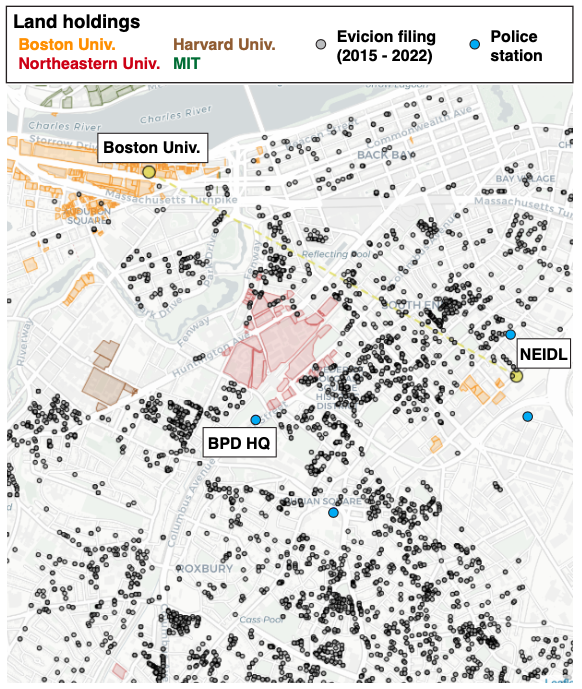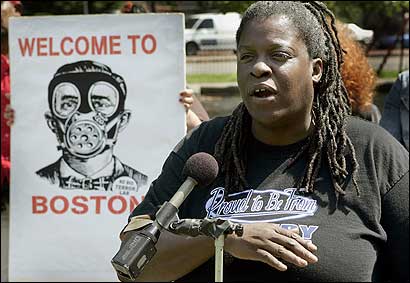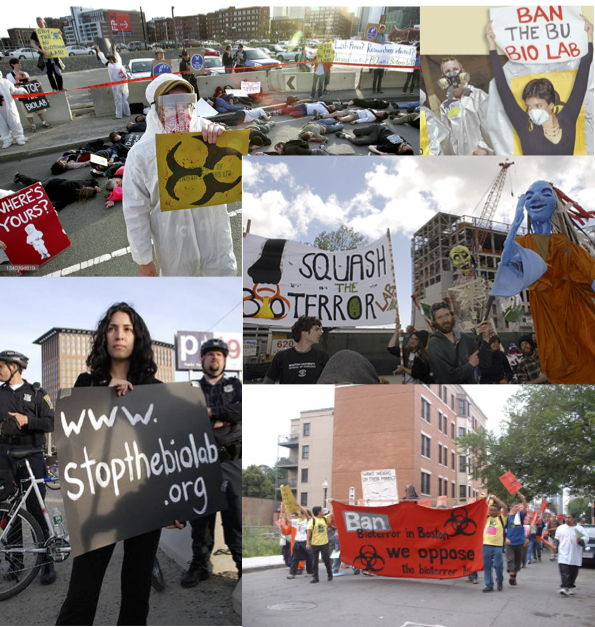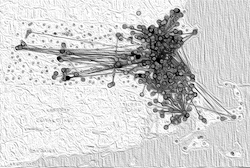- Type: University
- Complicit in: Ecological Harm, Ethnic Cleansing/Displacement ('Gentrification'), Health Harm, Militarization, US Imperialism
- 4 links
- Master entity: Boston University
- View on map
Boston University's National Emerging Infectious Diseases Laboratories (NEIDL) is a research laboratory located in Roxbury that grows dangerous pathogens – from Ebola to smallpox and anthrax – as part of the US’s decades-long efforts to weaponize biology and infectious diseases. The lab jeopardizes the health of neighboring residents and the environment. NEIDL exemplifies how universities colonize the city and put resources to work in the service of US empire.
Background: settler-colonialism and the US’s record of racist, biological warfare
The US has a long history of weaponizing biology in a reckless and racist manner, using viruses, microbes, and animal carriers of infectious disease. Biological warfare goes back to the earliest days of settler colonialism in which English settlers on Turtle Island exploited infectious disease in their war on Indigenous peoples while also harming their local food supply. English colonizers in Ireland and India had similarly attacked food sources and exploited epidemics for purposes of colonization and imperial control. Biological warfare has been part of US policing and counterinsurgency tactics at home. FBI director J. Edgar Hoover viewed the Black Panther’s Party (BPP) free breakfast program “the greatest threat” to the state’s effort to “neutralize and destroy” BPP, and in the 1960s Chicago police actually raided a church that stored the BPP’s supplies “and mashed up all the food and urinated on it.”
As the US gained more power globally following World War II, the US government began investing in more sophisticated weaponry, including biological weapons. Like other investments in militarism and war, this effort was presented as “defensive” and sometimes even disguised as being about “public health.” In reality, this research is meant to enhance the capacity of the US state to inflict harm, while the facilities where bioweapons are developed pose major risks to people’s health and to the environment. As always, colonized peoples become the targets and guinea pigs of the state’s most dangerous projects.
As Harriet Washington describes in her book Medical Apartheid, the US has continually exploited Black people for medical and scientific experimentation, including bioweapons experimentation. In 1952, the US army and the CIA jointly developed a bioweapons program called “MK-NAOMI” – part of the CIA’s notorious MK-ULTRA program – based in a laboratory at Fort Detrick, Maryland. The bioweapons developed by these programs were tested in Carver Village in Florida, a housing development that was open to Black people in a segregated, racist US South (Carver Village was named after George Washington Carver, a scientist for the people who had pioneered methods of cheap yet nourishing food production and sustainable farming).
Carver Village residents were already suffering from white terror: they were subjected to sometimes lethal violence and harassment from the local KKK, and in 1951 the complex was bombed with dynamite. The government added to these harms with bioweapons. As Washington described, the Fort Detrick laboratory “bred more than four million mosquitoes per day and released them in hordes,” including around Carver Village, during the 1950s. “By 1960,” Washington writes, “Carver Village residents had been plagued by a rash of mysterious illnesses, including the symptoms of dengue and yellow fever, and deaths.”
Another racist experimentation with bioweapons took place in 1955 at another Carver Village complex in Georgia (described in Harriet Washington’s book). Residents of Carver Village knew that they were being used as guinea pigs and that the US government’s “experiment” was making them sick. Dorothy Pelote, a Carver village resident, recounted how “young white men came to our house and talked with me and my husband. They said they were doing a study on mosquitoes and wanted to place a trap in our backyard to see how far they had spread in our area, but they didn’t go into detail. They lied. They said one thing when they were really doing something else. I [had] figured that they were from the Health Department.” Pelote added that “when people started getting sick and dying, I spoke with several people who recalled those boxes being placed in their backyards,” and concluded that “those people [government agents] used us as guinea pigs.” When the story of Carver Village made news in the 1980s after some relevant government documents became declassified, Pelote explained that her experience wasn’t unique: “when people [around Carver Village] started getting sick and dying, I spoke with several people who recalled those boxes being placed in their backyards. After the study, they came back and got the boxes from our backyard.”
The US government has never acknowledged the horrors it imposed upon these Black communities, and the victims and survivors of these US bioweapons attacks were never compensated. The CIA, as Harriet Washington notes, has in fact destroyed many of the files related to MK-ULTRA.
Over the years, the US has opened more bioweapons laboratories, which have had a variety of dangerous spills, accidents, and leaks. To give a few examples: in 2002, Lab 257, located on Plum Island in New York, had catastrophic spills due to power failures, spills which seriously harmed the health of facility workers (the state never acknowledged or compensated the workers for these harms). In 2014, USA Today reported that between 2008 and 2014 there were 1,100 leaks and accidents in bioweapons laboratories. And in 2019, the US army’s bioweapons lab Fort Detrick, Maryland suspended its activities after the Center for Disease Control concluded that the lab did not have “sufficient systems in place to decontaminate wastewater.”
Because of the dangers of these materials, the US government frequently establishes its bioweapons labs in predominantly working-class neighborhoods of color – areas that universities are eager to colonize – as the story of Boston University’s NEIDL demonstrates.
Community opposition to NEIDL
Historically, Boston’s “dirtier infrastructures,” like power stations, waste incinerators, and junkyards, and a variety of other “noxious land uses that were prohibited in other parts of the city” have been imposed on majority Black and Brown Boston neighborhood of Roxbury. Roxbury’s residents are subjected to evictions, criminalization, and organized abandonment by the state. As a dangerous bioweapons facility, NEIDL continues this pattern, which is why Roxbury residents have opposed the opening of the lab from the start.

As a coalition of residents and activists called Stop the Biolab explained, NEIDL “would research the most dangerous pathogens know to humanity…many of which can be transmitted through the air” and potentially harm neighboring residents. Stop the Biolab has documented the history of accidents, dangerous spills, and environmental contamination caused by US bioweapons facilities. Stop the Biolab has recognized that the US Pentagon “has been funding chemical warfare development for years” and notes the fear in the community "that this technology will be used to develop disastrous biological weapons.” Klare X. Allen, a Roxbury resident and organizer with Stop the Biolab and the Safety Net coalition of Roxbury residents of color fighting for health and environmental justice, has made NEIDL’s harms known over the years. Roxbury residents were outraged by the lab's plans. In 2005, Joan Miller, a Roxbury resident in her early 70s, was outraged by the lab, after learning about it from a meeting of seniors in which Allen spoke. Miller argued that the lab "should not be in this dense an area -- they ought to be ashamed of themselves. People have heard about this but whether people understand the impact, I don't know."

NEIDL was also opposed by some Boston University students, as well as by doctors and medical researchers, including some working at Boston University. In 2004, as Science magazine reported, “more than 140 scientists, physicians, public health professionals, and academics wrote to Boston Mayor Thomas Menino, arguing that the lab poses ‘real and catastrophic risks to the health and safety of people in the local and surrounding communities.’ ” At the time, Boston City Council was considering a ban on “biodefense,” promoted by community activists, which was ultimately defeated. And in May 2007, Stop the Biolab organized a “die in” in front of Boston’s ICA museum, which was hosting Massachusetts governor Patrick and Boston mayor Menino, to protest NEIDL.
Roxbury residents have continued to mobilize against NEIDL over the years and have continued to voice concerns over health and environmental safety. As Klare Allen told Boston’s WBUR radio station in 2012, NEIDL hasn’t addressed even basic questions about the facility, such as “How are we going to be safe? How are we going to eat? How will we be notified [in case of an accident]? Will there be an alarm? How is it going to be transported? What neighborhoods is it going through?”
Despite fierce opposition from the community, including a lawsuit (filed by Melvin King, Klare Allen, Joyce King, Carmen Nazario-Vega, and Conservation Law Foundation) against the National Institutes of Health, NEIDL eventually opened. In 2017, the lab received approval to do Biosafety Level 4 (BSL-4) research, which includes working with Ebola, Marburg, and other dangerous viruses, emblematic of how universities colonize the Boston area, especially working-class neighborhoods of color, and do as they please.
NEIDL presents itself to the public as a “public health” research lab that works to prevent outbreaks of deadly infectious diseases, such as Ebola. However, the major barrier to developing an Ebola vaccine – and making it available where Ebola outbreaks have taken place recently (such as the Democratic Republic of Congo) – is capitalism. Rather than creating desperately needed public health infrastructure for the development and dissemination of vaccines, countries outsource vaccine development to private biotech companies (via so-called "public-private" partnerships), enriching those companies, while leaving people vulnerable at the next outbreak.

Because of the success of grassroots organizing in delaying the opening of the lab, NEIDL had to develop more propaganda to give the illusion that it cares about what “the public” thinks. According to the lab's 2017 report, NEIDL's “Community Relations team” started giving tours to Boston University alumni, as well as to “regulatory officials, elected officials, business organizations, nonprofit community agencies,” and even “middle and high school students,” as these are all supposedly “stakeholders” in NEIDL. The lab employed postdocs at the lab to give these propaganda tours, and NEIDL’s report notes that “as part of a summer tour with a group of teenage girls interested in STEM, we asked a female researcher and a vet tech to describe their career paths. This led to a very lively and frank discussion. From youth to retirees, all have been impressed with the facility and our willingness to answer questions and share information.”
Government and corporate support for NEIDL
NEIDL receives government and corporate support. It was originally established in 2003 with a $128 million grant from the National Institutes of Health (NIH). Anthony Fauci of the NIH, who would later become tasked with heading the national response to Covid, spoke at NEIDL's 2017 symposium. NIH continues to support NEIDL. In 2021, for example, NEIDL’s director Ronald Corley received a $11.5 million grant from the NIH to support lab operations (similar amounts were given in prior years).
NEIDL is also heavily funded by the Pentagon through the DARPA agency. For example, NEIDL’s Paul Duprex (who has since left BU) received $999,992 from DARPA to work on viral infections between 2017-2019. According to records obtained by FOIA request, the Pentagon’s Biological Technologies Office (BTO) – which funds much of the bioweapons work in the US – gave over $4.2 million to Boston University biomedical researchers between 2014 and 2021. According to DARPA, such grants are meant to support research that will “have military or dual-use application.”
NEIDL’s other military-affiliated sponsors include the Geneva Foundation, which fosters medical research that is deemed relevant for the US war machine. (For example, Boston University NEIDL researcher Elke Mühlberger received funding from the Geneva Foundation between 2014-2017.) The Geneva Foundation’s aim, according to its website, is to provide “military medical researchers with a complete array of proposal development and award management services designed to secure funding and foster innovative research of specific relevance to the military community.” The Geneva Foundation also states that it works with other military labs to support research that is “focused on the operational needs of the warfighter.” The foundation is governed by current and former military officials, and collaborates with academia, hospital (including Mass General), and pharmaceutical companies (including AstraZeneca, Genentech, Novartis, and Pfizer).
NEIDL's other sponsors include pharmaceutical companies Merck and Takeda, and the Bill & Melinda Gates Foundation. These sponsors of NEIDL, Bill Gates and his network in particular, have worked hard to block the Global South from getting access to Covid vaccines so that they can continue to profit from "intellectual property," which shows once more that NEIDL and the forces behind it aren't interested in promoting people's health. The Gates Foundation has also funded and promoted dangerous experiments that unleashed over 2.4 million genetically engineered mosquitoes in the Florida Keys in 2021-2022 – as part of an experiment that tests a misguided "solution" to malaria (which is not a problem in Florida) - and is eerily similar to past government experimentation with mosquitoes in Carver Village. Bill Gates has also called on the US to pursue bioweapons research, using the usual imperialist argument that the US must develop bioweapons and antidotes to them lest such weapons fall into the hands of reckless "terrorists." Gates has used the Covid pandemic to promote this agenda. In November 2021, Gates called for the formation of a billion dollar per year program in bioweapons research, framed around the question: "You say, OK, what if a bioterrorist brought smallpox to 10 airports? You know, how would the world respond to that?" and adding that "there's naturally-caused epidemics and bioterrorism-caused epidemics that could even be way worse than what we experienced today."
Accidents and spills at NEIDL
As Steve Bailey wrote in the Boston Globe in 2005, Boston University labs working with dangerous pathogens have a history of accidents, including a case where three researchers were infected with tularemia, “putting two of them in the hospital, and spawning a series of investigations.” Yet, as Bailey points out, BU “never disclosed the problem at any of the public meetings” in order to not jeopardize the establishment of NEIDL.
Even a cursory look at NEIDL’s recent (and likely sanitized) reports reveals several alarming incidents:
- July 29, 2021: “a researcher working in the BSL4 [facility] had a pin hole in her (left) suit glove.”
- July 30, 2021: there was a record of a “near miss exposure to SARS-CoV”
- August 8, 2021: a researcher in a BSL-4 facility “had cut her outer glove and 2 inner gloves which caused her thumb to be exposed while disposing of waste that had been disinfected.”
- August 23, 2021: there was a report of “an Animal Core Technician working in the NEIDL BSL4 sustained a mouse bite to her thumb at 12:40pm. She was on supplied air and treated immediately by putting her hand in microchem.” According to the notes, NEIDL simply chose to have the animal technician – who was underpaid and doing dangerous work in this case – get further training in handling mice.
Further materials
About NEIDL
- Stop the Biolab website
- Roxbury activist Klare X. Allen’s testimony at Boston City Council hearing on BU Bioterror Lab (2016)
- “BU flunks the trust test,” Boston Globe (2005)
- “Roxbury, Massachusetts: Direct Action Civics and Biodefense,” in Community at Risk Biodefense and the Collective Search for Security (2015)
About state-sponsored development and use of bioweapons
- “Aberrant Wars” in Medical Apartheid: The Dark History of Medical Experimentation on Black Americans from Colonial Times to the Present (2017) by Harriet Washington.
- Deadly Cultures: Biological Weapons since 1945 (2006)
About US universities displacing and extracting profits from communities of color
- In the Shadow of the Ivory Tower: How Universities Are Plundering Our Cities by Davarian Baldwin (2021)
Master entity: Boston University
4 links
- Financial Support – Bill & Melinda Gates Medical Research Institute
- Association/Collaboration – Boston University Police Department
- Financial Support – Merck
- Financial Support – Millennium Pharmaceuticals/Takeda Oncology
NEIDL's sponsors include the Bill & Melinda Gates Foundation (of which the Bill & Melinda Gates Medical Research Institute is the biomedical research wing). Bill Gates and his network have worked hard to block the Global South from getting generic access to Covid vaccines and other lifesaving and life-improving medications, in an effort to preserve their ability to extract profits through patent regimes - another indicator that NEIDL and the forces behind it aren't about "public health." The Gates Foundation has also funded and promoted dangerous experiments that unleashed over 2.4 million genetically engineered mosquitoes in the Florida Keys in 2021-2022, as part of an experiment that tests a misguided "solution" to malaria (which is not a problem in Florida), eerily similar to past US government experimentation on black people with pathogens in communities such as Carver Village.
Bill Gates has also called upon the US to pursue bioweapons research, using the usual imperialist argument that the US must develop bioweapons and antidotes to them lest such weapons fall into the hands of reckless "terrorists." Gates has used the Covid pandemic to promote this agenda. In November 2021, Gates called for the formation of a billion dollar per year program in bioweapons research, framed around the question: "You say, OK, what if a bioterrorist brought smallpox to 10 airports? You know, how would the world respond to that?" and adding that "there's naturally-caused epidemics and bioterrorism-caused epidemics that could even be way worse than what we experienced today."
Boston University's former chief of police, Thomas Robbins, was tasked with providing "biosecurity" for Boston University's NEIDL's facilities. NEIDL is a lab that works to weaponize biology for the US government and military, while contributing to universities' harmful colonization of South Boston/Roxbury.
Merck is one of the corporate sponsors of the bioweapons research lab NEIDL. Merck also has a history of receiving lucrative contracts from the US army.
Millennium/Takeda sponsored one of NEIDL's conferences in 2017. Boston University's NEIDL is a lab that works to weaponize biology for the US government and military, while contributing to universities' harmful colonization of South Boston/Roxbury.
